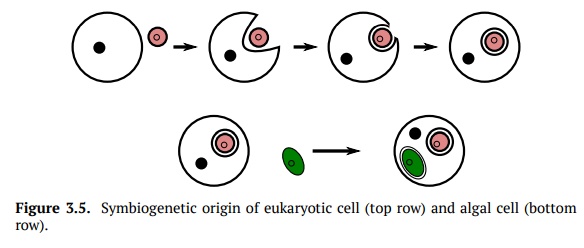Chapter: Introduction to Botany: Symbiogenesis and the Plant Cell
Mitochondria and Chloroplasts
Mitochondria and Chloroplasts
To escape from competition, cells which were
prokaryotic became larger. To fa-cilitate communication between all parts of
this larger cell, they developed cy-toplasm mobility using actin protein. In turn, this mobility resulted in acquiring phagocytosis, which is when a large
cell changes shape and can engulf (“eat”)other cells. This way, cells that used
to be prey became predators. These preda-tors captured prey by phagocytosis and
digested bacteria in lysosomes, which
use enzymes that destroy the cytoplasmic components of the bacterial cells. The
threat of predators result in cells became even larger, and these cells will
need a better supply of ATP. Some prey which were not digested, and turned out
to be useful in providing ATP (of course, predator cells should also invent a
proper transport through the resulted double membrane). Due to natural
selection, those prey, which were purple bacteria, became the cell’s
mitochondria. This is symbiogenesis,
or the formation of two separate organisms into a single or-ganism (Fig. 3.5).

Another result of a
larger cell (eukatyotic cells are typically 10–100 fold larger than
prokaryotic) is that the size of DNA will increase, and to hold it, the cell
will form a nucleus. The new predator cells also needed to prevent alien
organisms from transferring their genes which will delay the evolution. The
other reason is that the nucleus protects the DNA by enclosing it; in case if
DNA virus comes into the cell and tries to mock up cell DNA, eukaryotic cell
immediately destroys any DNA found in the cytoplasm. One more reason to make
nucleus is pressure of antibiotics: nucleus improves isolation from these
harmful chemicals. Nucleus formation and symbiogenesis leaded cells to become
eukaryotic.
Note that to be an
eukaryote, it is more important to have phagocytosis and mi-tochondria then
nucleus because (1) nucleus is not always exists, it could disap-pear during
the division of cell and (2) some prokaryotes (planctobacteria) also have
membrane compartments containing DNA.
On next step, some
eukaryotes also captured cyanobacteria (or another photo-synthetic eukaryote),
which became chloroplasts. These photosynthetic protists are called algae.
In all, eukaryotic
cells are “second-level cells” because they are cells made up of multiple
cells. Cells of all eukaryotes have two genomes, nuclear usually has biparental
origin whereas mitochondial genome normally originates only from mother. Plant
cells, in turn, have three genomes, and
chloroplast genome is usu-ally also inherited maternally.
Chloroplasts
synthesize organic compounds whereas mitochondria produce most of the
cytoplasmic ATP. Both organells are covered with two membranes and contain
circular DNA and ribosomes similar to bacterial. Chloroplasts have thy-lakoids,
or inner membrane pockets and vesicles. Chloroplast thylakoids could be long (lamellae) or short and stacked (granes).
Chloroplasts are
normally green because of chlorophyll which converts light energy into chemical
energy. Some chloroplasts lose chlorophyll and become transparent, “white”,
they are called leucoplasts. Other
chloroplasts could be red and/or orange (chromoplasts),
because they are rich of carotenes and xan-thophyls. These pigments facilitate
photosynthesis and are directly responsi-ble for the fall colors of leaves.
Since starch is a more compact way of storing energy than glucose, chloroplasts
store carbohydrates as starch grains. Trans-parent amyloplasts contain large granules of starch. Storage tissues of
potato tubers, carrot roots, sweet potato roots, and grass seeds are examples
of tissues rich in amyloplasts.
Having chloroplasts
and cell walls are not directly connected, but almost all or-ganisms with
chloroplasts have also cell walls. Probably, this is because cell walls do not
facilitate cell motility, and for those protists which already have cell walls,
obtaining chloroplast will be the nice way for coming out of competition with
organotrophic beings.
Related Topics